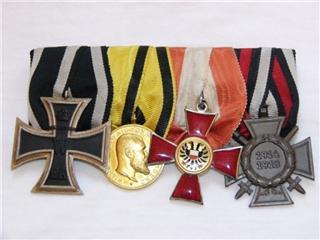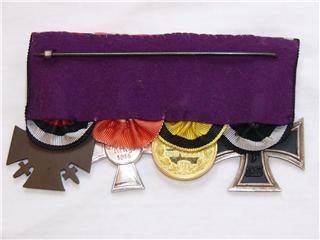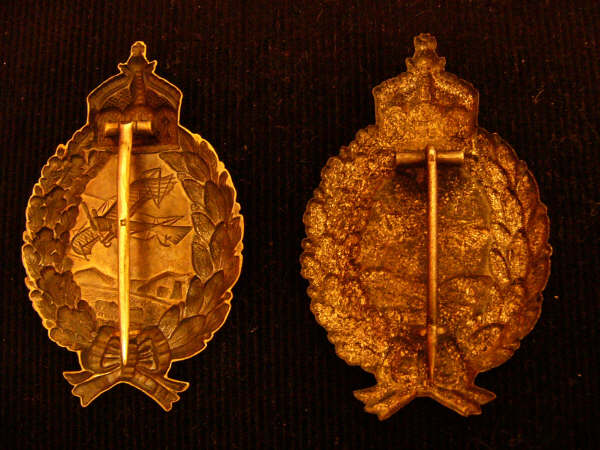-
Posts
2,932 -
Joined
-
Last visited
-
Days Won
11
Content Type
Profiles
Forums
Blogs
Gallery
Events
Store
Posts posted by Claudius
-
-
Wow,
That is a beautiful bar, congratulations. Hopefully Rick can come up with something for you. To a novice like myself it would seem a bar like this would be instantly ID'able, but as the saying goes and I'm learning, "the devil is in the details".
Sam K.
Those are both nice bars!
That would be cool if they could be identified.
0 -
Thank you both for your research!

It's nice to narrow it down to a few gentlemen, and will be great when it can be eventually attributed to one individual. I might even be able to find other awards (1st class pin awards, i.e. EK1) that he earned.
I understand, for instance, that while the W GMVM USUALLY came after the EK1 award, it didn't always happen in that order, if at all.
0 -
-
I think I have it this time. Front-

 0
0 -
Hello Claudius,
Thank you for joining in, unfortunatly no picture is showing up ?
Cordial greetings,
Sorry. Computer issues with the photos...I will correct and re-send. I have to reformat them to be small enough to fit as an attachment.
0 -
Here's my L?beck for this collection of medal bars. It's very nicely done. The EK2, L?beck and Hindenburg are all tied down. And with the Wurt. GMMM I'm hoping this is traceable. I would like to know who this gentleman was.
0 -
David;
See my PM!
Cutting that list down.
0 -
I agree with Haynau.
BUY IT.
Nobody can perfectly explain why they would buy the bar, but most of us feel that we would buy it -if we were presented with it.
0 -
Here is a bar with some bars....

 0
0 -
Here is a "mechanical" translation of the text:
House medal
House medals have a long tradition in the house Saxonia Coburg and Gotha. The today's "Saxonia Coburg and Gotha' house medals" go on the "medal of German probity" out of the year 1689 (other sources: 1690) back. The "medal of German probity" was created by duke Friedrich I. of Saxonia Gotha in memories to his father, duke Ernst the pious one. This medal is considered as the first German lay knight medal (see Nimmergut, Joerg, German medals and decorations until 1945, S. 1369, 1999) (isolated it is called even "first German medal", see castle, Paul, the medal of German probity, Leipzig 1921).
The foreign exchange of the medal was at that time already "Fideliter et Constanter" (faithfully and steady). It is also today still the foreign exchange of the house. Successor of the medal of German probity was the Saxonia Sachsen-Ernestini house medal. This medal was again donated to 1833 of the dukes Bernhard Erich friend of Saxonia Meiningen and Ernst I. of Saxonia Coburg and Gotha as well as hereditary prince Joseph von Sachsen-Altenburg as "Herzoglich of Saxonia Sachsen-Ernestini house medals".
He tied to the past principles and maintained also the medal foreign exchange "Fideliter et Constanter". The "medal of German probity" was already conceived as a "honour honor of the Fuerstlichen of members of our house and at the same time as public acknowledgment of earnings/services". Also the Saxonia Sachsen-Ernestini house medal was an honor for "state servants and Unterthanen, those with German probity, by excellent Thaten, special loyalty and devoted devotion excellent requirements on the attention and gratitude of the state acquired itself" (from the preamble of the statutes of 1833). The medal originally consisted of four classes (conditions 1833): Large cross Comthure 1. Class Comthure 2. Class knight beside it existed still another decoration with the stages "Distinguished Service Cross" and "earnings/service medal", affiliertes with the medal. With the award of the large cross to not-noble persons the acquisition of all rights of the birth aristocracy was connected. The number of medal awards was limited by the statues. Beside the princes of the houses involved maximally 9 further large crosses could be lent after the statutes of 1833. The other 3 stages were on altogether 12, 18 and/or. 36 awards limits. Starting from 1864 the restrictions became on 12 large crosses, 15 Comthure 1. Class, 24 Comthure 2. Class and 48 knights increase.
The number of the Distinguished Service Crosses and medals was unrestricted. 1864 was introduced also further classes, so that starting from this year the following partitioning existed:
Large cross Comthure
1. Class Comthure
2. Class knight
1. Class knight
2. Class as well as Distinguished Service Cross earnings/service medal in gold earnings/service medal in silver the Saxonia Sachsen-Ernestini house medal was lent to 1935 and represented one of the most outstanding earnings/service honors (see Illing, Fritz, Orden and Ehrenzeichen of the states of Thuringia 1590-1935, S.
19) Constructing on the extinct Saxonia Sachsen-Ernestini house medal now in the year 2006 by prince Andreas, Saxonia Coburg and Gotha, the Herzoglich Saxonia Coburg and Gotha' house medals were donated to the head of the house. Also with this medal outstanding earnings/services are appreciated around public interest and the house Saxonia Coburg and Gotha. Following the historical models the medal consists today of the following classes: Large cross Comthurkreuz knight cross as well as decoration that affiliiertes with the house medal Distinguished Service Cross The medal chancellor Dr. Otmar joining man
0 -
Agreed! Wonderful bars. Earlier I meant that it hurt not to have them in person to examine. No different with these last two submissions. Nice ones. Any other beauties WNickel, (perhaps from other states?)
0 -
That hurts....that really hurts. Seeing all these St. Henry's on bars....
Very nice and my compliments.
0 -
Wow.
I would like to see some good color photos of that bar!
0 -
-
Do'H!
 I meant Bremen Oldenburg. Thanks dond.
I meant Bremen Oldenburg. Thanks dond.  0
0 -
Nice Bars! I especially like the lubeck and hessian one. Please show the backs as well...
0 -
-
-
Sorry about that. Used a different computer that wouldn't let me save as a normal attachment.
Here they are...front

 0
0 -
-
-
Hello all;
This is the first medal bar. At the time, I had no idea how uncommon it was. Not the medals, however. The medals are somewhat common. What makes this a favorite five of mine is the combination and the maker stamp on the back. While a cloth maker tag is uncommon and nice to find, this one is an ink stamp. A close up is included, but even in person the lettering is becoming hard to read. But on the fourth line I can just make out the city of "Koblenz".
I think the combination of medals is interesting because this gentleman was eligible to receive the Centennial medal in 1897, stayed alive through WWI and earn an EK2, and Hessian equivalent and was around in 1934 to get the Hindenburg cross. A non-com.????
0 -
That is very interesting that "flaw" you found on all prussian cliche' badges. When I get home I will need to look at that a little closer.
0 -








Werner Gropius
in Germany: Imperial: Rick (Research) Lundstrom Forum for Documentation and Photographs
Posted
Does anybody have any details about Werner Gropius. I know he was a pre-war officier and became an Observer in WWI, earned the EKII.
Thank you in advance.